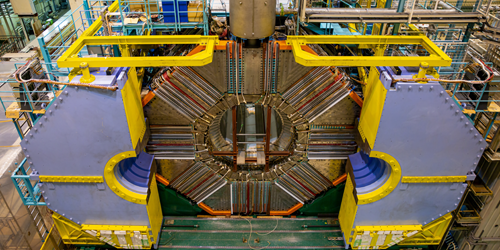Standard Model Stays Strong for Leptons
Newly released data taken using the Belle II experiment at KEK in Japan and the LHCb experiment at CERN in Switzerland show no sign of a possible anomaly that researchers think could provide a route to overturning the standard model of particle physics [1–3].
According to the standard model, electrons, muons, and tau leptons should all behave identically when subjected to any of the fundamental forces of nature. Over a decade ago, researchers began questioning the validity of this assumption—known as lepton universality—when they observed high-energy particle decays that deviated from standard-model predictions. Specifically, the observations concerned the decay of B mesons into various leptons, with the experiments hinting that a few more tau leptons were being produced than expected. Excitement built among particle physicists, who hoped they were on the cusp of finding the long-sought standard-model violation that would uncover new physical phenomena. Hopes rose further as other experiments found hints of lepton-universality violations in the decay of B mesons into electrons and muons, but the signals remained too small to rule out experimental artifacts.
Then at the end of last year, hopes began to fade when the LHCb Collaboration released data for B-meson decays involving electrons and muons that exactly matched standard-model predictions [2, 3]. Now data from the Belle II Collaboration for a different B-meson decay involving electrons and muons dim those hopes further [1]. The studies provide some of the most stringent lepton-universality tests yet in such decays. But researchers haven’t yet given up on leptons unlocking a door to new physics, says Belle II Collaboration member Henrik Junkerkalefeld of the University of Bonn, Germany. He notes that, although the results provide new constraints on the options for undiscovered physics, they don’t completely rule them all out.
–Katherine Wright
Katherine Wright is the Deputy Editor of Physics Magazine.
References
- L. Aggarwal et al. (Belle II Collaboration), “Test of light-lepton universality in the rates of inclusive semileptonic B-meson decays at Belle II,” Phys. Rev. Lett. 131, 051804 (2023).
- R. Aaij et al. (LHCb Collaboration), “Test of lepton universality in b→sℓ+ℓ− decays,” Phys. Rev. Lett. 131, 051803 (2023).
- R. Aaij et al. (LHCb Collaboration), “Measurement of lepton universality parameters in B+→K+ℓ+ℓ− and B0→K∗0ℓ+ℓ− decays,” Phys. Rev. D 108, 032002 (2023).




